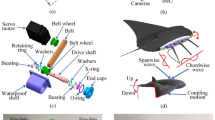Abstract
This paper shows that a biology-based neural network (called a central pattern generator (CPG)) can be re-evolved for sea conditions / frequencies. The fish’s CPG operates at 1.74Hz to 5.56Hz, whereas we require performance to reach 0.05Hz to 0.35Hz (20s to 3s waves) for an alternative engineering problem. This is to enable adaptive control of wave energy devices, increasing their efficiency and power yield. To our knowledge, this is the first time a bio-inspired circuit will be integrated into the engineering domain (and for a completely different function). This provides great inspiration for utilising other neural network mechanisms for alternative tasks.
Preview
Unable to display preview. Download preview PDF.
Similar content being viewed by others
References
Finerva.com, http://www.finavera.com/en/wavetech/
National Aeronautics and Space Administration (NASA), Intelligent Flight Control System (2005), http://www.nasa.gov/centers/dryden/news/FactSheets/FS-076-DFRC.html
Arena, P., Fortuna, L., Frasca, M., Sicurella, G.: An Adaptive, Self-organizing Dynamical System for Hierarchical Control of Bio-inspired Locomotion. IEEE Trans. Syst. Man Cybern. B Cybern. 34(4), 1823–1837 (2004)
Pelamis Wave Power, http://www.pelamiswave.com/
Moskowitz, L.: Estimates of the Power Spectrum for Fully Developed Seas for Wind Speeds of 20 to 40 Knots. Jour. of Geophysical Research 69(24), 5161–5179 (1964)
Cohen, A.H., Wallén, P.: Fictive Swimming Induced in an in vitro Preparation of the Lamprey Spinal Cord. Experimental Brain Research 41(1), 11–18 (1980)
Grillner, S., McClellan, A.D., Sigvardt, K., Wallén, P., Wilén, M.: Activation of NMDA Receptors Elicits fictive locomotion. Lamprey Spinal Cord in vitro, Acta Physiologica Scandinavica 113, 549–551 (1981)
Ekeberg, Ö.: A Combined Neuronal and Mechanical Model of Fish Swimming. Biological Cybernetics 69, 363–374 (1993)
Patel, L.N., Murray, A., Hallam, J.: Increased Swimming Control with Evolved Lamprey CPG Controllers. In: Int. Joint Conf. on Neural Networks, pp. 2195–2200 (2005)
Patel, L.N., Murray, A., Hallam, J.: Super-Lampreys and Wave Energy: Optimised Control of Artificially-Evolved. Simulated Swimming Lamprey, Neurocomputing 70, 1139–1154 (2007)
Author information
Authors and Affiliations
Editor information
Editors and Affiliations
Rights and permissions
Copyright information
© 2009 Springer-Verlag Berlin Heidelberg
About this paper
Cite this paper
Patel, L.N., Murray, A. (2009). A Biologically Inspired Neural CPG for Sea Wave Conditions/Frequencies. In: Köppen, M., Kasabov, N., Coghill, G. (eds) Advances in Neuro-Information Processing. ICONIP 2008. Lecture Notes in Computer Science, vol 5506. Springer, Berlin, Heidelberg. https://doi.org/10.1007/978-3-642-02490-0_12
Download citation
DOI: https://doi.org/10.1007/978-3-642-02490-0_12
Publisher Name: Springer, Berlin, Heidelberg
Print ISBN: 978-3-642-02489-4
Online ISBN: 978-3-642-02490-0
eBook Packages: Computer ScienceComputer Science (R0)



